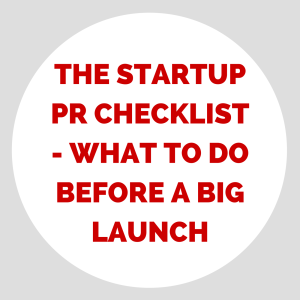 For early stage startups, cash-strapped and overworked, there are few things more valuable than PR. There is nothing more important at that stage than getting the word out there and getting users on board, for which PR is the only real shortcut available. And when there is an important feature release or a launch or a funding announcement and so on, all of which can be leveraged to get your startup up into the fickle spotlight, you need to be on your best game.
For early stage startups, cash-strapped and overworked, there are few things more valuable than PR. There is nothing more important at that stage than getting the word out there and getting users on board, for which PR is the only real shortcut available. And when there is an important feature release or a launch or a funding announcement and so on, all of which can be leveraged to get your startup up into the fickle spotlight, you need to be on your best game.
Here’s a small PR checklist that can be used as a starting point for campaigns. Based on a plan I’d made for a company I consult for, it can be used for different domains with appropriate tweaks.
Press Release
Write the draft yourself. Don’t let your PR agency write it. Remember that most wires will just pick up your release and distribute it. Writing the release itself let you control the small nuances that would make an impression on a reader. No PR person, as good a writer as they may be, will know exactly what you want to say or be able to communicate what you know. Ask them to review and edit it later, of course. But when your positioning needs to be clearly articulated, no one can do it better than you.
Tip – Read the PRs which made an impression on you. See what caught your attention. Replicate.
Reach-out mailers
About three weeks before your release date, prepare a small outbound list of tech journalists, podcasters and bloggers, and start reaching out to them with the story you want them to tell. The best case scenario would be that you have built up a relationship with the journalists and bloggers over some time, and are now in a position to leverage it. If not, this is as good a time to start as any. Try to tell them a story, give them a ‘hook’ to write about and ask them if they’d be interested to write about you. Most will not, a few will, but maybe next time, when there’s an even bigger launch, they will. And what coverage you get now for the story will be a bonus.
Tip – Have a list of journalists you consider important on your table. Mail them at intervals, give them tips, ask their opinions on vital debates. Be useful and interesting to them, basically. They’ll be more receptive when you reach out to them later.
Homepage
Connect the Press Release’s story with the homepage. In effect, make the homepage the landing page for that day, so there’s a smooth experience for the reader who’s coming in from reading the release. If they say different things, you may lose his/her attention. But when what is said on the release connects snugly with the homepage, there is a higher probability for the reader to spend time on the site. You can check how many readers actually followed this process, read pages or clicked on CTAs to know how this worked, so you can tweak it on future releases.
Blog
Write at least two tangential/related stories about the release on your blog, preferably personal stories of how the team built this, or how it impacted a specific customer and so on. This way, readers who arrive on the site through this story have additional reading material to spend their time on. Though this isn’t spoken about more often, the blog is often a measure of organisational credibility. For example, I sent a senior manager at Freshdesk a link to a young product that could have been useful in sales processes. The first thing he told me was that since the company did not seem to write anything on their blog, he didn’t have anything to judge them on. The product seemed okay enough, but he didn’t know if he could trust them. This is something product marketers should take not of.
Tip – An article or two on Medium would also help. Medium, being the heavily tech-oriented community that it is, can sometimes get your story noticed more. Again, all of this is possible only if there’s a good story people actually want to read. None of this is useful otherwise.
Case Studies
At least one case study should be there on the home page, where the customer has used the new feature you are releasing. A good case study can be fantastic collateral for a feature release or a product launch; readers who arrive from the news will know immediately that what has been told to them and interest in which has led them here, is already out there being used. This again raises the probability of them clicking on CTAs or getting on mailers or even buying the product itself.
And so on and so forth. There are a lot of these things startups can do on the contextual level that will make the arriving reader spend more time on the page and convert. For the startup with limited money and marketing budget, which needs to ensure that not a single reader who arrives trickles away into the ether, these tricks of the inbound trade are definite aces-up-sleeves.
If there are other things that you have done, or which I have forgotten about early in the morning as I write this, please add them in the comments.

